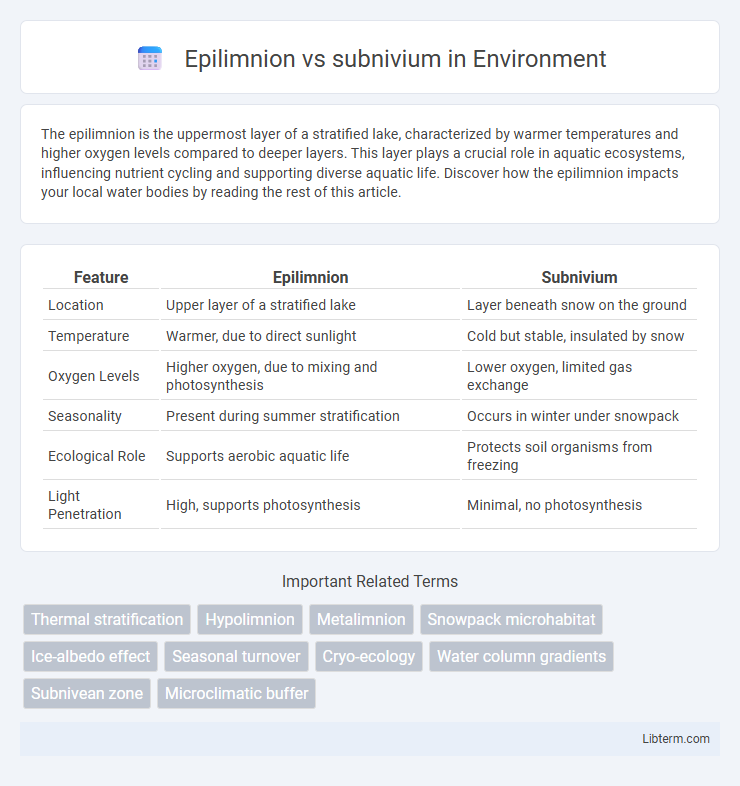The epilimnion is the uppermost layer of a stratified lake, characterized by warmer temperatures and higher oxygen levels compared to deeper layers. This layer plays a crucial role in aquatic ecosystems, influencing nutrient cycling and supporting diverse aquatic life. Discover how the epilimnion impacts your local water bodies by reading the rest of this article.
Table of Comparison
| Feature | Epilimnion | Subnivium |
|---|---|---|
| Location | Upper layer of a stratified lake | Layer beneath snow on the ground |
| Temperature | Warmer, due to direct sunlight | Cold but stable, insulated by snow |
| Oxygen Levels | Higher oxygen, due to mixing and photosynthesis | Lower oxygen, limited gas exchange |
| Seasonality | Present during summer stratification | Occurs in winter under snowpack |
| Ecological Role | Supports aerobic aquatic life | Protects soil organisms from freezing |
| Light Penetration | High, supports photosynthesis | Minimal, no photosynthesis |
Introduction to Epilimnion and Subnivium
Epilimnion is the upper, warm, and well-oxygenated layer of a stratified lake, characterized by higher light penetration and active biological processes during warmer months. Subnivium refers to the insulated microenvironment beneath snow cover, where temperature remains relatively stable and provides refuge for small animals and plant life during winter. Both zones play critical roles in aquatic and terrestrial ecosystems by regulating thermal conditions and supporting diverse organisms across seasonal cycles.
Defining the Epilimnion Layer
The epilimnion is the uppermost layer of a stratified lake, characterized by warmer temperatures and higher oxygen levels due to direct sunlight exposure and surface mixing. This layer typically extends from the water surface down to the thermocline, where temperature drops sharply. Understanding the epilimnion's role in heat distribution and aquatic ecosystems is crucial for studying lake dynamics and seasonal stratification processes.
Understanding the Subnivium Zone
The subnivium is the insulating layer beneath the snowpack where temperature remains stable just above freezing, providing a crucial habitat for overwintering organisms. Unlike the epilimnion, which is the warm upper layer of stratified lakes exposed to variable atmospheric conditions, the subnivium offers thermal protection and moisture stability essential for small mammals, insects, and plant roots during harsh winters. Understanding the subnivium zone reveals its role in ecological resilience by maintaining a microenvironment that buffers temperature extremes under snow cover.
Physical Characteristics: Epilimnion vs Subnivium
The epilimnion is the warm, oxygen-rich upper layer of a stratified lake, characterized by higher temperatures and active mixing due to wind and sunlight exposure. In contrast, the subnivium is a microhabitat beneath the snowpack and above the frozen ground, featuring stable, insulated temperatures and high humidity that protect overwintering organisms. While the epilimnion experiences significant thermal fluctuations and light penetration, the subnivium maintains a relatively constant, cold environment with minimal temperature variation.
Temperature Dynamics in Epilimnion and Subnivium
The epilimnion, the upper warm layer of a stratified lake, experiences rapid temperature fluctuations driven by solar radiation and atmospheric conditions, often reaching peak temperatures during summer. In contrast, the subnivium, the insulated zone between snow cover and ground in winter, maintains relatively stable temperatures just below freezing, protected from extreme cold by insulating snow. These temperature dynamics influence biological processes, with the epilimnion supporting active aquatic life during warmer months and the subnivium providing a critical thermal refuge for microorganisms during winter.
Biological Communities and Adaptations
The epilimnion hosts diverse aquatic organisms adapted to warmer temperatures and higher oxygen levels, including phytoplankton, zooplankton, and fish species thriving in sunlight-rich environments. In contrast, the subnivium provides a stable, insulated microhabitat beneath the snow, where cold-tolerant invertebrates and small mammals exploit reduced temperature fluctuations and protection from predators. Biological adaptations in the epilimnion include heat stress tolerance and oxygen exploitation, while subnivium inhabitants exhibit antifreeze proteins, metabolic rate reduction, and behavioral strategies to survive harsh winter conditions.
Ecological Significance of Each Zone
The epilimnion, the warm upper layer of a stratified lake, supports high oxygen levels and abundant photosynthetic activity, critical for sustaining aquatic life such as fish and plankton. The subnivium, the insulated microhabitat beneath snow and ice, provides thermal stability and protection for overwintering insects and small mammals, maintaining biodiversity during harsh winters. These zones collectively enhance ecosystem resilience by offering distinct habitats that regulate temperature, oxygen, and shelter across seasonal cycles.
Seasonal Variations and Their Impacts
The epilimnion, the warm, upper layer of a stratified lake, experiences significant seasonal temperature fluctuations that influence aquatic life and nutrient cycling, promoting oxygen-rich conditions during summer months. In contrast, the subnivium, the insulated zone beneath snow cover on soil surfaces in winter, maintains relatively stable, near-freezing temperatures that protect overwintering organisms from extreme cold. These seasonal variations in both layers dictate ecosystem productivity, species survival, and biogeochemical processes, highlighting their critical roles in freshwater and terrestrial environments.
Human Influence on Epilimnion and Subnivium
Human activities such as deforestation and urbanization significantly alter the temperature and nutrient dynamics within the epilimnion, affecting aquatic ecosystems by increasing sediment runoff and elevating water temperatures. In contrast, the subnivium, the subnivean zone beneath snow cover, experiences indirect human impacts primarily through climate change, which reduces snowpack depth and duration, thereby disrupting its thermal insulation role vital for overwintering plants and animals. These human-induced changes in both layers influence biodiversity and ecological stability by modifying habitat conditions and energy exchanges.
Future Research Directions and Environmental Concerns
Future research on the epilimnion and subnivium should prioritize understanding their roles in climate change resilience, particularly how temperature stratification in the epilimnion influences aquatic ecosystems and how the subnivium's insulating properties affect terrestrial overwintering species. Advancements in remote sensing and in situ monitoring technologies will enable precise data collection on thermal dynamics and snowpack interactions, fostering predictive models for ecosystem responses to shifting seasonal patterns. Environmental concerns include the potential disruption of epilimnion turnover processes and the degradation of subnivium habitats due to warming winters and snow cover loss, which threaten biodiversity and ecosystem stability.
Epilimnion Infographic

 libterm.com
libterm.com